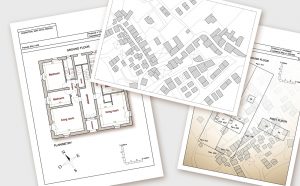Land Registry Searches provide information relating to property and land ownership, mortgages, property boundaries, restricted covenants, charges, right of way, current and past ownership, and property prices. You can find information about registered land or property through a Land Registry search even if you are not the owner. Today, we’re going to take a closer look at what kind of information is included in a Land Registry Search and how that information can be used.
Why is Land Registered?
The land registry exists to clearly set out the following:
- Who owns the land and the property if there is a property on it
- The boundaries of that land
- Rights of way that affect the land
- Whether there are any restrictions in place affecting the land
Prior to 1925, land was largely unregistered, and registration was voluntary. The 1925 Land Registry Act sought to streamline the conveyancing process and allow land purchasers to see the title to land through a document called the Title Information Document. The requirement to register land was rolled out across the UK over many decades, culminating in 1990 – by which point the entire country was required to register land every time it came under new ownership. The trigger for registration happens whenever land is mortgaged or sold.
It is estimated that 85% of all land across England and Wales is now registered, with the current Land Register containing more than 24 million titles. As for the remaining 15%, there are several reasons why land may still be unregistered. One of the most common reasons is that the land and property that sits on it have been under the same ownership for many years, and the trigger to register the land hasn’t happened. Once this land is sold or re-mortgaged, the land registration process will be triggered, and the land will be added to the Land Registry.
Why is the Land Registry Important?
The Land Registry protects and guarantees the rights of landowners, provides a reliable record of information regarding land ownership and factors that affect the land, and a Title Plan that indicates the boundaries of the land. It’s a crucial part of the purchase and sale of land, providing absolute proof of ownership and a clear plan outlining the extent of ownership.
By creating a clear record of land ownership, owners are better protected against adverse possession – also known as squatting – and fraud.
What is Included in a Land Registry Search?
Two primary documents are be obtained from a Land Registry Search; the Title Register and the Title Plan. Together these documents provide proof of ownership and detail the terms on which the land and property on said land are owned. Anyone can obtain these documents for properties registered in England, Wales, Scotland, and Ireland. So, what’s the difference between the two?
The Title Register
The Title Register – often called the Title Deed – contains the following information:
- Description of the property and tenure
- Name and address of current owners
- Purchase price (if purchased after April 2000)
- Name and address of mortgagee and other changes if applicable
- Covenants, easements, cautions, notices, and restrictions
The Title Plan
The other document included in a Land Registry Search is the Title Plan, which contains:
- Outline of the property in relation to the surrounding area
- Details and coloured marking referencing information from the Title Register that illustrates rights of way, rights to access, watercourses (not drainage) and any sections of land affected by easements and covenants
The boundaries of the registered land are always illustrated in red ink. Despite being accurate and based on OS mapping, boundary indicators on Title Plans are intentionally designed to lack precision when zoomed in. This may seem counterproductive, but it helps prevent new boundary disputes arising that did not exist before it was possible to use a computer to inspect the boundaries in minute detail.
Is it sometimes possible to access older copies of Title Deeds – although this is entirely dependent on when the land you’re searching for was first registered.
What are Land Registry Searches Used For?
Primarily, the documents obtained from Land Registry Searches are used to aid the transfer of land and property from one owner to another. They prove that the property owner is the legal owner of the land and property.
Title Deeds are the final word in determining any dispute over who legally owns the land. If the land is registered, then a Land Registry search will definitively establish who owns the land, has rights of access, and has a financial interest in land and/or property. Any land or property that does not appear on the Land Register should be approached with caution, and similarly, if you own land that isn’t registered, you should seek to register it voluntarily. Whilst it is possible to sell land or property without the Title Deeds, the process is a lot more complicated.
We hope this article answered your questions about Land Registry Searches. If your company needs assistance with the administrative elements of Land Registry Searches or any other business administration – Company Registrations Online can help. We can assist with all manner of company searches and company formation including company winding up search and company registration packages. Contact us today if you have any questions.









